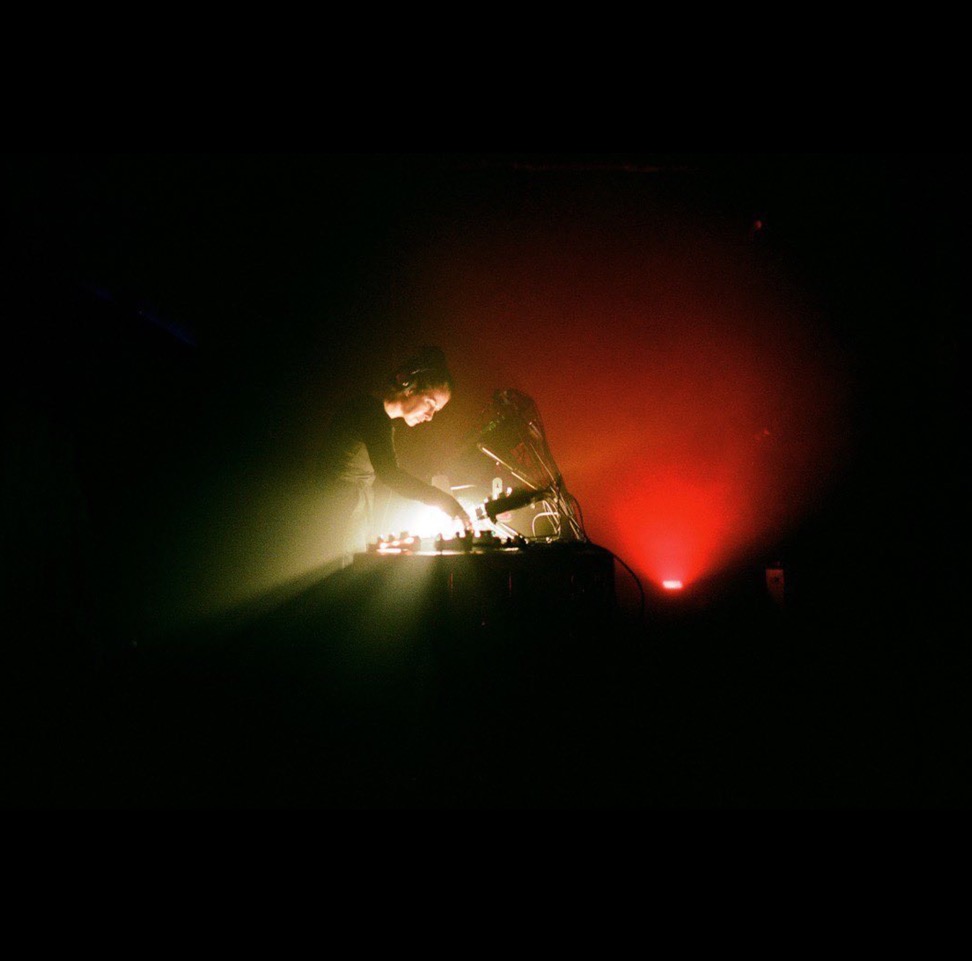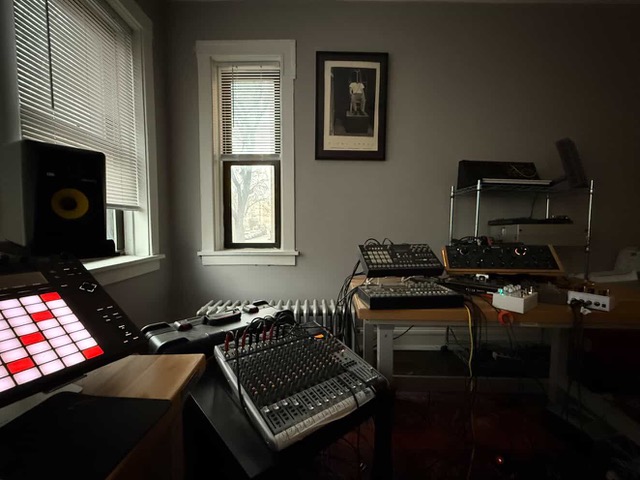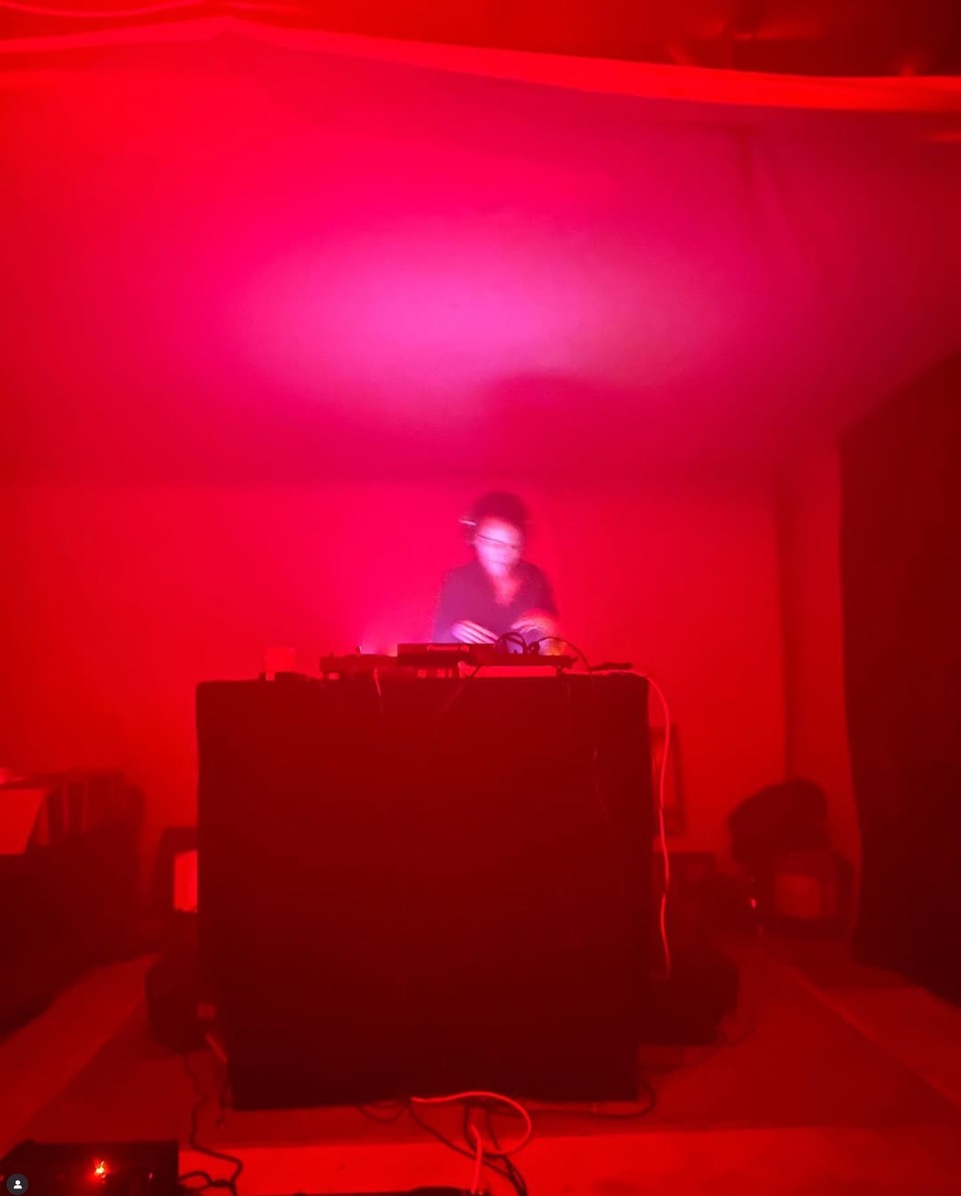randy's Recent Posts
I'm starting Team Notes as a place for me and other folks on Team Madrona Labs to post more casual things for a smaller audience. If you're seeing this, I guess you're that audience. Welcome!
Typical posts might be special interests within our special interest: technical details about making the software, or about making the coffee, what we're listening to, rants on technology and how it's making everything better or making everything worse, recipes... you get the idea. If there's anything you've always wanted to know, please reply here with your ideas!
This orange clipboard has my notes from the current Sumu optimization. I'm figuring out how to run four of the Moog filters in parallel in around the time it previously took to run one, and thinking about how to generalize this solution in an elegant way. I still do big abstract thinking much better when I'm using actual pen and paper.
Making code faster with SIMD (Single Instruction, Multiple Data) processing is something I've enjoyed doing since Motorola first released their Altivec-enabled PowerPC processors. From Altivec to SSE and AVX and ARM NEON, the SIMD concept has remained largely the same across processor generations for the last 25 years. Compilers have gotten better at optimizing C++ code for SIMD, but to get the fastest results, the right algorithms and data structures have to be picked to kind of make the CPU happy, which is much higher-level thinking. And zooming out even further there are more human-centered tradeoffs to think of: what kind of code reduces the potential for bugs, what is redadable and maintainable, what will be easy to learn for new people coming aboard the project? Are we optimizing for just the latest Apple machines, or do we want this stuff to be runnable on a ten year old ThinkPad? The questions may start out purely technical, but very soon the answers start to reflect an organization's values.
Sumu makes heavy use of SIMD already in its oscillator banks. But the 4x filter object is one that had to wait until after the initial release. Between this and other optimizations, Sumu 1.2 will use around 30% less CPU than 1.1.3. And there's more optimizing to come. My goal is to run it on this ten year old ThinkPad over here!
Thanks everyone! Sooooo much moss wants to grow on our roof here in the Pacific Northwest. I think I'm going to hire a professional.
Thanks for the additional info. If you can email me at support@madronalabs.com and send a crash log, it will help me figure this out.
Hey @intervolver I hear you are pretty frustrated with the sample import process, even without the crash. Obviously, you're not alone. I have plans to make it better.
As far as the crash, please contact me at support@madronalabs.com. I'm not getting any crashes with importing here, so maybe it's the specific files you are importing that can cause it. I'd like to get a hold of them and try to reproduce the problem.
Maybe it's overwriting the created .sumu files that is causing the crash? When you describe reimporting on your edit, one difference is that the files already exist. If you try deleting all the .sumu files in the folder you're writing to and importing again, you could test this. I'll do so as well.
It's a commonly asked question so I'm copying this info to a new thread in hopes it will be found more easily.
The Vutu app makes .utu files. These are a plain-text, editable, JSON format containing partials maps.
In Sumu, you can import the .utu files. The import process creates .sumu files, which are compressed to save space. The import also does some more analysis and saves it in the compressed file.
To import .utu files in Sumu, click the [...] in the Partials module. There's just one choice in this Popup menu: import partials. Then select a folder to import.
When you import a partials folder, it imports the whole directory tree underneath the one you pick, including any folders that contain .utu files.
So if I have on my disk
~/VutuFiles/Strings/cello.utu
~/VutuFiles/Strings/viol.utu
~/VutuFiles/Noises/tinkle.utu
~/VutuFiles/Noises/harsh/blender.utu
and then bring up the import dialog (partials/...) and select the folder ~/VutuFiles to import,
the files
~/Music/Madrona Labs/Sumu/Partials/Strings/cello.sumu
~/Music/Madrona Labs/Sumu/Partials/Strings/cello.sumu
~/Music/Madrona Labs/Sumu/Partials/Noises/tinkle.sumu
~/Music/Madrona Labs/Sumu/Partials/Noises/harsh/blender.sumu
will be created, along with the directories on the way.
Importing again will (for now) overwrite these files.
The intention is to "sync" your entire partials development folder at once. So if you make a folder somewhere called "VutuPartialsForSumu" or something, with everything you want to import into Sumu, and always select it when you import, you will keep your partials organized based on that folder's structure.
-Randy
Looks tasty!
These are already imported into .sumu format! So, you do the following:
- go to our Google drive
- click the "..." to download the whole theory folder
- put the theory folder in .../Madrona Labs/Sumu/Partials with all the other partials.
The "import partials" converts utu files into .sumu format. You do not need to do that here.
We have had MPE support since version 1.1.0.
With the Sumu 1.1 release out, VST3 versions of Aalto, Kaivo and Virta are the top priority now. We're working hard on them.
Hi, sorry your post got buried—feel free to hit me up via support @ madronalabs any time.
I appreciate the feedback. I know importing partials is super clunky. Part of this is for legal reasons: the Loris software that I use to do the analysis is under a GPL license and would require that my entire synthesizer be open source, if I were to incorporate it. I have plans to address this in the future and make the workflow much better.
You mention some Vutu things I can definitely improve. The '90s are hip again but I can definitely do better on some workflow things.
At some point I plan to add parameter locks which would take care of the voices issue.
People have different ideas about which way is "correct" for scrolling. There's a setting in the main "..." -> GUI -> normal / reverse.
I hope you are enjoying the sounds, please stay tuned and I will work to improve other things about the software.
Wow, this is a weird one. Please keep us posted on whather the 3D driver fix is helpful!
Happy October! I've just uploaded an update to Sumu, version 1.1.3.
This update brings fixes to two main issues with version 1.1.0. On Mac OS, a crash in AU validation was affecting users with Intel-based computers. This has been fixed. On Windows, an expired code signing certificate was causing difficulties in downloading. This is also fixed.
Along the way I discovered a few additional problems. Here's a full list of the changes since 1.1.0:
- fix AU validation crash on Intel processors
- add Azure code signing for Windows DLL and installer
- fix JSON-related bugs in partials import
- fix rare crash in space display rendering
- fix running on MacOS 10.13 and higher
- optimize JSON parsing for very long files
- fix FM mod index bug
Because of the bug fixes, I recommend this free update to every Sumu user. Installers are over here!
Hi @lumena, sorry it's giving you trouble, can you identify a particular .utu file you are importing that is causing the issue? Does it ever succeed? Please follow up with me by email at support @ madronalabs.com if you would like to send a file.
Maybe not too distant!
Now that Sumu is out with MPE, I'm working to make VST3 updates of the other synths with a fix to the keyboard problem and a couple of other long-standing bugs, ASAP.
Glad to hear!
The Sumu 1.1 update is out, bringing MPE support as well as a bunch of bug fixes and enhancements. These include:
- gui: fix scrolling after setting default in popup dials
- gui: fix missing update bug when pasting registration
- osc: fix zipper noise in AM mod index
- AU wrapper: fix Obj-C namespace collisions
- fix UI scale bug with muliple displays of different scales
- allow slower LFO times
- increase LFO popup dials precision
- adjust text position for negative numbers in Dials
- increase pulses ratio dial precision
- fix slow LFO sync
- improve host clock sync
- reset pulses hi scale offsets when adjusting past zero
- fixed issue loading state saved by beta version
- added MIDI learn for dials via popup menu
- added main […] menu with gui and input settings
- gui : added numbers on / off menu
- gui : added scroll normal / reverse menu
- input: added protocol [MIDI / MPE] menu
- input: added MPE bend range [ 0 / 12 / 24 / 48 / 96 ] menu
- input: reduced latency of gate and pitch in patcher
- input: added MPE mode
- input: don't reset voice time in unison mode legato
- partials: add interpolation to time dial
NOTE: we are still working on meeting the latest requirements for Windows code signing. Windows will claim that the Sumu installer may be dangerous and you will need to click "Keep anyway" a few times. We'll update the installer as soon as we can address this.
Hi Peter, the way to do it is to use Sumu to import the .utu files. There's info in the manual and I've just made a new Quickstart from some info on the forums:
I hope this helps, if you have any questions please email me at support.
best,
Randy
Wow, that's interesting. I guess the other profile is for Direct3D?
Of course it's still not ideal if there's a setting you have to change to use Sumu but I'm glad you have a workaround.
received thanks!
Thanks. I have a Windows 11 machine here. Do you have a utility you are using to track GPU memory usage? I'm happy to research this but using the same one will help me reproduce what you are seeing.
Hi and thanks for the report. This is not familiar to me. I can check into it. What operating system are you using please?
Hi, sorry for the delay, I had one last long weekend adventure this summer.
It could be that your import is actually successful. The message "partials file not found" should show up in the partials module only when the patch itself is referring to a partials file that it can't find. Are you trying to load a patch you've downloaded and the partials to go with it?
After loading the folder "Vutu" that you made, what you should expect to see is the one partials map (utu) in the top level of the menu in the partials module. If you look in the Madrona Labs/Sumu/Partials diretory, you should see that one file in there converted to a .sumu file. Once you choose it from the partials chooser the "partials file not found" message shbould go away.
@cupcake thanks for the info! And sorry for the confusion. I'll look at the installer and try to remedy this.
Yes, it's currently unsigned as we complete the verification process for code signing. Meanwhile thanks for your patience.
Hi, after posting the download links I've learned that on Chrome, just clicking does not work. By right-clicking and selecting "save as," you should be able to download the installer. You may also need to tell the browser "Keep anyway" until our code signing has completed.
You don't need to uninstall Sumu, just install over the previous version.
Midi learn and CC control are in this version, 1.1. Please see the manual for more details.
The Murder Gal At The Courthouse: Criminal Investigator Proximal/Distal Moonlights As A Brilliant Techno Producer
by Dave Segal
“Drexciya changed my life, changed how I viewed music and my relationship to electronic music—how complex it could be while still being distilled to an essence. It's perfect,” says Jennifer Trezza, aka techno/ambient producer Proximal/Distal in a Zoom interview that took place in August 2025, shortly before her move from Chicago to Seattle.
“I have this super-cringe photo of me, probably taken in 2002, playing some goofy-ass, non-attended show in Atlanta."
In Atlanta in 2002, techno and electro was not a thing. It was all horrible indie rock and handbag house. But there was a tiny group of us into techno and electro, and there's an embarrassing photo of my doing a live show in a boiler suit and ski mask. I stanned those dudes so hard.” Trezza laughs, but the picture she paints of her youthful enthusiasm for the legendary Detroit group is utterly endearing.
If you don't know who Proximal/Distal is, it's understandable. Yes, she has a loaded SoundCloud page, but no official releases, save for tracks on the compilations Basement State & Friends and Sonic Adventurers Consortium Vol. 2 and a remix of Conner Jones' “BruteFarce.” Two Proximal/Distal live performances have been uploaded to YouTube (including her ripping 2019 set at Seattle's Velocity Fest) and she's played live and DJed a bunch with Portland IDM crew Tarantella and at Detroit's Temple Bar. This ostensible lack of productivity is deceptive, though.
Proximal/Distal's low profile stems from a hatred of self-promotion and, as she admits, “I'm really terrible at finishing things. I probably have like 1,500 half-finished songs on my computer, and so many jams. I dunno... once the idea is out, I'm done with it. I wanna do something else. I'm really bad at the follow-through. Which is okay. You can make stuff just because you like the process of making it.”
Another factor hindering Proximal/Distal's music career is the fact that she's moved a lot. Among other places, she's lived in Portland, Seattle, Detroit, London, and Chicago. “Every time you move, you have to tear down and reset everything up. It takes four or five months before everything gets unpacked and you haven't been working and you're miserable. You lose it and you gotta get it back.”
Trezza's day job as a licensed criminal defense investigator is, to understate things, unusual for a musician. She had been working for the Cook County Public Defenders office in Chicago and will take a similar post in King County/Seattle in September. “There's crime everywhere. If you do what I do, you can do the job in any state. My job is really second-hand traumatic. I'm the murder gal at the courthouse I'm assigned to. I work on all the homicides that come through. It's gory work. It's a violent world out there. A lot of my clients have really sad stories, like neglect, poverty, and injustice. It's hard to get that off you at the end of the day.
“I don't like to make art about it, because I just want to separate myself. So I always say that I make music as a response to it. I come home and I want to unwind, so I want something that reminds me that there's beauty in the world, there's art. It's not just people killing each other.”
For Trezza, making music is definitely an escape valve. “I would explode if I didn't do it,” she says, laughing. “I would fucking die. There's really no point in anything else. I derive some satisfaction from my job. It's an important job that matters. I have a lovely dog whom I love. I have wonderful friends and family. But everybody has to have that thing that's the point of their existence. I love music so much. If I don't have time to express myself in that way and I don't have time to noodle and play, I get horrifically depressed. So I have to do it.”
Trezza started making her own music in 2001 after moving back from London, where she'd bought her first synthesizer. “It was this big digital Oberheim that they put out—a big blue keyboard. I think it might have been the OB-12. I remember the hassle of getting it shipped home with me when I brought it back stateside. It was, yeah, I'm gonna learn how to sequence this thing and make music with it.”
Trezza's formative years occurred in the '90s, and her enthusiasm for music accelerated when a friend turned her on to industrial music at a young age. Soon after, she got into punk and then rave music. “Then this goofy thing happened called electroclash. It was so simplistic that I realized, hey, I can do this. You listen to the first Peaches record [The Teaches Of Peaches] and think, hey, that's something I could do. It was a gateway drug to Drexciya and the whole Detroit techno sound. That's really my first love and favorite music. I feel fortunate to have gotten to live in Detroit and get to be in the Motherland.”
Even as an outsider, Trezza was able to slot into the Detroit music scene while she was there, but she does admit that it was “really intimidating, because literally everybody is talented. You go to any bar and there's some nobody kid DJ coming up already club-grade... It's just a musical town and there's so much of it. But people are so nice and accepting. I recently DJed Body Worx at Temple Bar, my friend Dretraxx's night. He's an amazing musician and DJ. There are so many opportunities to play live or DJ. I don't think you're gonna do better in the US, as far as inspiration and the legacy of electronic music. It's still happening all the time, even though people say it's over; it is not.”
You can hear the Detroit techno influence on Proximal/Distal's recordings and live performances, but elements of dark and hard European artists such as Surgeon, Oliver Ho, and Autechre also surface. Then there's “Infinite Raccoon Lives,” a glassily psychedelic, chill techno cut from the Basement State & Friends comp and P/D's peak, “E-girl”—hard-driving, bleepy, and clattering techno with an eerie melody in the background. The 2019 track “Colfax, 4 a.m.” and a 2021 hardware/modular live set from 2021 prove that P/D can excel at melodically advanced techno, as well.
The name of Trezza's newest project, Desdemona Club, was inspired by a dive bar in a Twin Peaks-y area of Oregon, near Astoria. “I got tired of writing techno for a little while and I wanted to do something that was less 4 on the floor, less structured in that sense. [Desdemona Club] is more ambient and experimental. I released one of those tracks on the Tarantella compilation Audioglyphs [find it on Bandcamp].” Tarantella is both a Portland IDM crew and label headed by Sean Millican. Trezza's also done some DJ mixes for the imprint that reflect her excellent taste in weird ambient music.
I wonder if Trezza creates music with a utilitarian goal in mind—like, say, for club DJs or for potential licensing in films? “I don't. I don't even try to anymore. Trying to create for very specific scenarios has been a contributing factor in why I find it hard to finish stuff. Not only am I done with the idea, but then I've got this idea that I'm trying to force into a format.
“I DJ, too, and it's easier to mix in songs that are structured a certain way, right? And, man, I just don't want to write that. [laughs] Sometimes I don't wanna have to stick a drumbeat stem intro on the beginning of stuff. I find it mentally anxiety-making. I don't make myself do that anymore. The beauty of divorcing yourself from the idea that you're going to have some sort of musical career, there's gonna be some expectation for releases, that I can just write whatever I want to.”
Trezza became fascinated with Madrona Labs products after reading an interview with Rrose (aka Seth Horvitz, aka Sutekh, who used to record for Madrona Labs founder Randy Jones' Orac label) in which they said they used ML plug-ins. “I thought, 'woah, what is this? These are fucking cool.' There's some weird, organic VST plug-in. I love Kaivo. I've probably used Kaivo on everything. It's so organic; it's beautiful. So, that's how I first found out about it.
“Then I played Velocity Fest in Seattle and, oh my god, here's the Madrona Labs guy who made the plug-in I love so much! I fangirled pretty hard. I've come back to them recently, because I'm moving cross country to Seattle, and I knew this was coming for months, I've been packing up my studio. So, I've not been using a lot of my hardware and I've been working a lot in the box. I'm playing a show in Seattle with some friends right when I get there [August 29 at Mountain Bar], and I can't bring a bunch of shit with me. So I was going to use a laptop with a weird MIDI controller setup. I think Kaivo will figure very heavily in the set. There's nothing better, in the box, for weird, dynamic percussive sounds.”
Besides Kaivo, Trezza's Madrona Labs arsenal includes Sumu. She views it as “a way to reuse sounds that I'm either sick of or haven't been able to quite get where I want to. Maybe I can make a partial out of them and give some life to them that they didn't have before.”
As for Trezza's musical agenda for the near future, she says, “I have some songs that are dangerously close to being completed, so I would like to finish them. I have a monthly night in Chicago that I do with some pals... I don't want to call it a goth night, but it's not a techno night. We're just weird freaks who like Throbbing Gristle. [laughs] It's really fun. I'm going to miss it. I want to find someplace where I can DJ at regularly [in Seattle]. It's so nice just to show up with a USB stick and not have to bring half your studio with you.”
This is Clementine.
Desdesmona Club plays August 29, 2025 at the Mountain Room in Seattle.
There are more customers than usual having issues with the Sumu installers in version 1.1.0. These problems fall into two categories so far:
Windows code signing issues. The fix for this is known but I did not want it to hold up the release. Those of you who are comfortable clicking "Keep anyway" can use the new installer without further issues, hopefully. Meanwhile I'm working to get the signing process completed for an update ASAP, hopefully in the next week.
Mac OS validation issues. On older operating systems (10.x), the validator is crashing. I'm working on a fix.
Mac OS install issues: these are less common and could be related to AudioUnits caching. If the plugin is not recognized after install, you can try clearing your AudioUnits cache as described here: https://madronalabs.com/topics/8791-how-to-clear-your-audio-unit-cache
Finally, if you need to you can always you can reinstall Sumu 1.0.
See these links for the Sumu 1.0 installers:
MacOS - http://madronalabs.com/media/sumu/Sumu1.0.0.pkg
Windows - http://madronalabs.com/media/sumu/SumuInstaller1.0.0.exe
@aejonel Thanks for the feedback. As the interface matures, hopefully it will annoy you less. Meanwhile, enjoy the sounds.
Thanks for the report. I've added this to the issues list. As soon as I can fix the installer issues with this version I'll try a higher sample rate in Reaper and see if I can reproduce.




